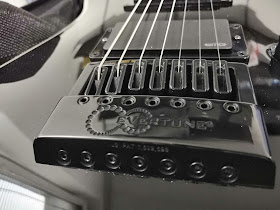Hello and welcome to this week's article!
Today we're going to talk about a very specific type of fixed bridge for guitar (click here for a dedicated article about fixed bridges): the Evertune bridge!
The Evertune bridge is a type of bridge that requires a specific casing from the guitar, which consists in a wide hole on both sides (similar to the one for a Floyd Rose but larger) and even by removing quite a lot of wood it adds a large amount of weight to the guitar.
Said like this it sounds quite bad, but the truth is that if you go to see the guitars that are actually used on stage or in studio from many of the most famous professional guitarists of today, odds are there is an Evertune.
Why? Because this type of bridge delivers an impossible promise: to not having to tune your guitar (almost) ever again.
This magic is achieved by a system that uses a concept similar to the one of the Floyd Rose but that reverses it: with a Floyd Rose you move the bridge to alter the pitch of the strings, and then a set of springs placed in the back of the guitar tries to put the bridge back into its original position, while with an Evertune, once you set perfectly everything, there will be a spring that will pull independently each string, forcing it to stay to its original tuning.
The result is a guitar that takes around 60/90minutes to set up perfectly (instead of the 15/30 of a normal one), but that stays in perfect tune indefinitely, and that even by changing strings, as long as the gauge doesn't change, doesn't need any additional mantainance.

What are the practical outcomes of this? Is it worthy? It is, definitely: in my case, even if my guitars are usually set up and intonated by a luthier or by myself after every string change (because I like to use different gauges every now and then), I had the feeling (and you notice it mostly when recording) that for the first time I have used a guitar without any micro-pitch alteration throughout the whole fretboard (I have it in my LTD MH-1007 ET).
How does it work? It's easier done practically than explained, and for the details I suggest you to check out the videos in the Evertune website, but the concept is this: for each string there is a saddle in the bridge, and the saddle can be in 3 positions: Zone 1 (when there is not enough tension), Zone 2 (when the string is in tune but not bendable, because every bending is compensated), and Zone 3 (when the note starts to become sharp and the string is bendable).
After you have found the right pitch and intonation, you should turn the peg in the headstock until the string arrives to Zone 3, and then loosen it a bit until it goes back to the perfect pitch: this way you will have the ideal pitch AND the string will be bendable, it's called "the sweet spot".
You can even decide which string can be bent and which not, for example you can set it so that the lower strings are unbendable, and that are basically used only for rhythm part with perfect pitch, while the higher strings will be freely bendable (you can even adjust the bending sensitivity!), and this versatility is really stunning, so my bottom line is that this bridge is probably the first real useful guitar innovation since decades.


No comments:
Post a Comment